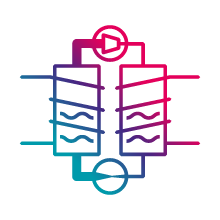Solar Thermal Technologies
Technology
- Parabolic Trough Collector
- Fresnel
- Low concentration flat collector
Approach
The project will demonstrate solar thermal as a cost-effective solution. To do this, it will investigate various technologies for large-scale collectors and advanced hydraulic concepts designed for huge arrays.
Costs expected to fall by 20-75% compared to current state-of-the-art collectors.
Biomass Technologies
Technology
- Low pollution-biomass boiler
Approach
To further reduce the emissions, Selective Non-Catalytic Reduction and Selective Catalytic Reduction techniques will be tested.
Geothermal Energy
Technology
- Hybrid solar geothermal district heating system
Approach
To increase energy efficiency and reduce costs of individual components, a system will be designed, which integrates
- hybrid solar photovoltaic (PV),
- ground-source heat pump,
- buffer tank storage technologies and
- borehole heat exchangers for passive cooling.
The outputs of each technology are highly complementary to one another and have the potential to increase.
Cool from Renewable Energy Sources
The project aims to create an innovative and versatile cooling technology able to produce cooled air using diverse sources of renewable heat. This technology should be compatible with any kind of district heating system (even working at very low temperature) to enable universal replication.
- Advanced absorption chiller with internal heat recovery
The goal is to enhance the performance of the absorption chiller by means of internal heat recovery. If successful, this technology will allow combined district heating and cooling in a single infrastructure development, which would deliver higher efficiency and be viable for large-scale implementation.
Data Centre Heat Waste Recovery
Technology
- Recovery of waste heat with fuel cells
Approach
Data centres will recover waste heat through the integration of fuel cells. These fuel cells can raise the temperature of waste heat, which makes this system adaptable to a wide number of district heating and cooling networks.
As part of the process, the fuel cells will generate electricity, which will be used to power the data centre while the excess heat will be supplied to the local district heating and cooling grid.
Storage
Technology
- Molten salt-based thermal energy storage
Approach
A thermal energy storage system based on molten salts will be integrated into a district heating and cooling system.
As molten salts have a massive storage density, the volume of the storage tanks can be reduced by up to 20 times compared to other storage technologies. This means lower installation costs.
Molten salt tanks can also act as boilers, avoiding the use of fossil fuel boilers to cover demand peaks. This reduces operational and capital costs as neither fuel nor extra equipment are needed anymore.
ICT System
Approach
Computer systems will form the basis of the energy management, providing the optimal integration of all the district heating and cooling components.
For the first time, the following will be tested in the district heating and cooling networks: machine learning for demand prediction, artificial intelligence for management support, SmartSCADA with GIS maps and automatisation of procedures.
Other conventionnal technologies
The project will also make use of conventional high efficiency technologies, which will be integrated in different demo sites

Absorbtion chiller

Heat water storage

Solar thermal collector

Heat pump
